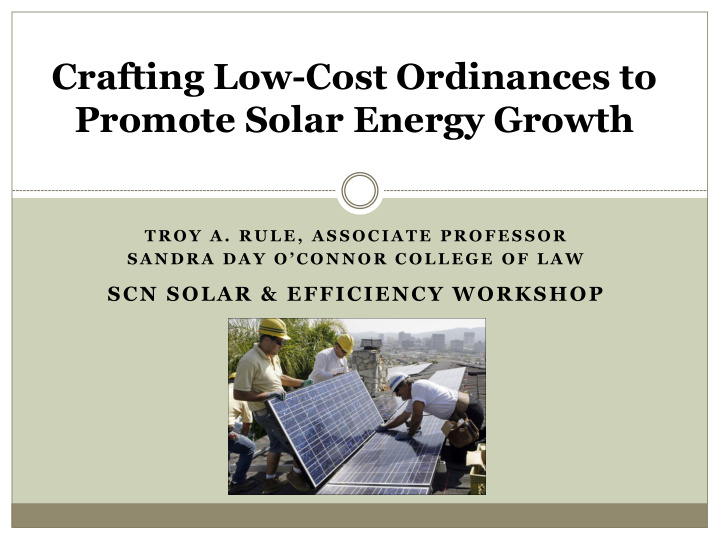



Crafting Low-Cost Ordinances to Promote Solar Energy Growth T R O Y A . R U L E , A S S O C I A T E P R O F E S S O R S A N D R A D A Y O ’ C O N N O R C O L L E G E O F L A W SCN SOLAR & EFFICIENCY WORKSHOP
Arizona’s Existing Energy Mix www.solar-nation.org
Arizona: Limited Coal Resources www.teachcoal.org
Arizona: Limited Natural Gas Resources
Arizona Solar Energy Resources
Rapid Growth in Solar PV Installations Credit: greentechmedia.com
Utilities’ “Death Spiral” Narrative As more customers switch to solar, utilities sell less power . Consequently, utilities must raise their rates to spread their high fixed costs over fewer sold kilowatt hours. These higher electricity rates make solar power even more cost- competitive , motivating even more customers to get solar panels. hotstocked.com
Solar Panels Property Line Neighbor’s Land Solar User’s Land
Burdened Airspace Uncompensated Airspace Easement Solar Panels Property Line Neighbor’s Land Solar User’s Land
Sunlight Law Prior to the 1970’s The Old English “Doctrine of Ancient Lights” United Fee Ownership Rule ( Ad Coelem doctrine) Fontainebleau Case (1959): No implied right to sunlight under US Law
Modern Approaches to Solar Access “Solar Rights” Statutes 1. Wyoming & New Mexico Zoning/Setbacks 2. Ashland, Oregon (solar setbacks) Boulder, Colorado (solar fences) Nuisance Law 3. Classifying solar panel shading as a public or private nuisance No statutory solar access protection 4. majority approach ; relies upon voluntary covenants/easements
Protecting Solar Access: The Iowa Approach Under Iowa’s statute : Neighbors are not generally liable for shading solar 1. panels, however: If a solar panel user is unable to negotiate a voluntary 2. solar access easement, the local government can compel the neighbor to sell the easement for its market value.
Advantages of the Iowa Approach Consistent with existing law re: airspace rights Does not take neighbors’ airspace rights without compensation Addresses the solar access problem Provides a guaranteed means of getting solar access protection Encourages rooftop solar energy development Promotes the efficient use of scarce airspace Rational solar users will only elect to purchase solar access easements when they are the highest-valued use of the space.
Crafting a Solar Access Ordinance Create a solar easement application process Statements re: good faith negotiations & minimized neighbor impact Provide for notice and a hearing Limit easement duration to a solar panel’s useful life Exempt neighbors’ existing vegetation/structures Require applicants to bear some city costs
Development Exactions Exaction – a condition to development approval requiring the developer to provide something to a local government. Exactions can be in the form of : Required improvements (sidewalks, public art, etc. ) Property dedications (for roads, parks, etc.) Monetary exactions (cash) Linkages ( e.g ., day care for office buildings, affordable housing requirements, etc.)
Promoting Solar Energy through the Development Approval Process Development approvals could be conditioned upon : (1) installation of on-site solar energy generating capacity ; (amounts based on number/size of lots or developed floor area) (2) the purchase of equivalent credits in commercial-scale solar energy facilities elsewhere in the city; OR (3) payment of fees in lieu of on-site solar energy installations (funds generated through such fees would support local commercial-scale solar energy projects)
William Fischel’s “ Homevoter Hypothesis” “…[H] omeowners … tend to choose those [local government] policies that preserve or increase the value of their homes.”
Impact of a Solar Energy Installation Requirement (for New Homes) on Home Prices $ S 2 S 1 P 2 #1 : Solar mandate requirements tend to increase P 1 the cost of new housing, as reflected by upward shift in the #2 : This market supply from S 1 to S 2 reduction in housing supply D increases the equilibrium price of new Q 2 Q 1 Quantity of homes from P 1 Housing to P 2
Can This Work? Some Real-World Examples Renewable Energy Mitigation Program (Aspen and Pitkin County, CO) Builders of new homes larger than 5,000 sq. ft. or having certain outdoor energy uses must : install on-site solar/geothermal energy systems (based on sq. ft.) OR pay a fee (revenues help to fund local sustainable energy projects) Solar Energy System Requirement (Lancaster, CA) Requires 1.o to 1.5 kW of solar per lot/unit Allows developers to fulfill requirement off-site
Publicly-Owned Commercial-Scale Solar City Hall, Bainbridge Island, WA
Advantages of Commercial -Scale Solar over Residential -Scale Solar Lower hard costs per kW Lower soft costs per kW Lower permitting, sale/lease, installation, design, interconnection, and inspection costs per kW Fewer solar access conflicts per kW Less aesthetic impact per kW More manageable grid impacts
Recommend
More recommend